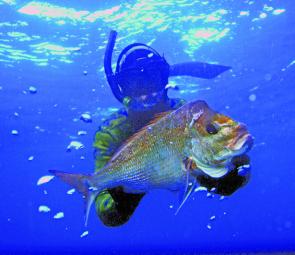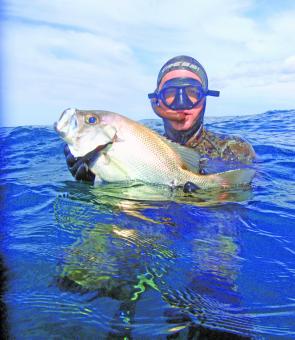Spearfishers and anglers will invariably cross paths in their shared passion for the ocean. As with many areas of modern life, the way we conduct ourselves can make these interactions a positive or negative experience.
By sharing a common understanding of each other’s craft we can help to ensure that both groups enjoy their passion safely and get the most out of a day of fishing.
Spearfishers and anglers often meet when a spearfisher is swimming close to the edge of the rocks. The best thing to do if you see someone fishing on the rocks is to give them a wide berth - swimming at least 50m out and around their spot. Make sure that if you intend to make a dive in the vicinity you stay well away from the area that their line is cast.
Most commonly spearfishers will be passing through the area so any disruption to the fishing spot will usually only last a few minutes while the diver swims past. If you do need to swim under a fishing line, it’s a good idea to give the fisher a signal to let him know that you’re just swimming past.
If an angler is in an area you wanted to dive, move to another spot and try coming back later. At spots like Whale Beach in Sydney, there are commonly 10-20 anglers chasing salmon on the northern rock platform. In a situation like this, it is a good idea to try either diving further along the headland or moving to another spot altogether.
The beauty of diving is that you have the ability to swap spots and look around for ground without having to pack up your gear. By keeping well clear, signalling intention to swim past and saying hello on the way out, rock hoppers both above and below the water can both go home wiser and happier at the end of the day.
FADs are a popular spot for both spearfishers and line fishers. Because of the small area and close proximity, all user groups must be courteous and respectful to ensure the best outcomes and safety.
When approaching a FAD, it’s important to respect people that may already be fishing the area. Make sure you take the time to approach other vessels and let them know you will be diving. By finding out how long they intend to stay you can make a decision on waiting for them to finish or drifting in turn.
A float and flag are essential when diving at FADs. Not only do they allow passing boats to see you but they also ensure your boatie can keep an eye on where all the divers are. There have been a number of boat strikes in recent years with horrible consequences.
In many situations it can be very difficult to see a diver and at these times you should exercise extra caution. Choppy seas, late afternoons and early mornings are especially high risk times. By towing a float and flag, you maximise your chances of being seen and minimise the risk of boat strike.
Make sure your drift line is well clear of where existing fishers are drifting and that your path won’t intersect with their activities. Don’t hog the best spot, get a few fish and head off.
Usually, if there are mahi mahi at a spot, you will see them as soon as you get in the water. By extending your drift, it allows others to drift in sequence and also might give you a chance at a fish like wahoo, which tend to hang out a bit wider of the FAD. Don’t hang directly off the FAD because it means that no one else can have a go at catching a fish from around it.
As a spearfisher, you have a great insight into what is going on under the water. Too many times I have seen fishers walking all the way out to the end of a headland and casting their line as far as possible when often the best fish can be found only metres from the rocks right in the corner of the beach.
By sharing your knowledge of what type of fish you saw and where you saw them you can help your misguided fishing friends and save them a long walk. In return, you might get an insight into what fish have been ending up in his bucket and how big the shark was he saw swim up behind you! Who knows, you might even convince them to don a wetsuit and jump in the water.
By communicating with fishers and sharing knowledge, both parties gain experience and if nothing else, walk away feeling happier. In respecting other fishers, whether they use a spear gun or fishing line, we only stand to gain and develop a better shared knowledge.
Winter has come and gone and the water has started to warm up in Coffs Harbour. With a balmy 20ºC in some spots the depths of winter already feel like a long lost memory. We’ve been out braving some big swells in the past weeks and have had some great conditions reward us.
A memorable day last month came when least expected. Diving in 15m of water I spotted a school of surgeonfish milling in and around a reef. I relaxed and started my dive in amongst the fish looking for anything out of the ordinary that might swim by.
Surgeonfish are a great species to hide amongst and attract other species like mangrove jack, blue barred orange parrotfish, Moses perch and small snapper. As I made my descent on the school, I noticed that right in front of me an unsuspecting snapper was hovering amongst the other fish.
Being one of the most notoriously difficult fish to spear, I was shocked to have this beautiful fish hanging motionless right in front of me. The fish turned slightly and I lined up a shot on his knob.
The fish didn’t flinch as I shot and I had him in the esky in the blink of an eye with a big grin on my face.
Until next issue, stay safe and dive with a float and flag.
Reads: 6291
Louis with a cracking snapper, a notoriously hard fish to spear.

Kitted up for rock hopping.

Sam Featherstone and Jai Shone show off an impressive mixed bag.

Justin Ward with a pearl perch.




